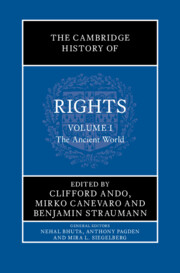3364760 results
Hans Sloane's Library Collection and the Production of Knowledge
- Coming soon
-
- Expected online publication date:
- October 2025
- Print publication:
- 31 October 2025
-
- Book
- Export citation
African Literature in Transition
- The Archive of African Literature, 1800–2000
- Coming soon
-
- Expected online publication date:
- October 2025
- Print publication:
- 31 October 2025
-
- Book
- Export citation
Cases in Simulated Disaster Medicine
- Coming soon
-
- Expected online publication date:
- October 2025
- Print publication:
- 31 October 2025
-
- Book
- Export citation
Catholicism: End or Beginning?
- Coming soon
-
- Expected online publication date:
- October 2025
- Print publication:
- 31 October 2025
-
- Book
- Export citation
A Hundred Flowers
- How Literature Shaped Maoism
- Coming soon
-
- Expected online publication date:
- October 2025
- Print publication:
- 31 October 2025
-
- Book
- Export citation
My Own Past
- Afrodescendant Contributions to Cuban Art
- Coming soon
-
- Expected online publication date:
- October 2025
- Print publication:
- 31 October 2025
-
- Book
- Export citation

Plays 1676–1678
- Coming soon
-
- Expected online publication date:
- October 2025
- Print publication:
- 31 October 2025
-
- Book
- Export citation
Population Control as a Human Right
- International Law and the Global Quest to Curb Overpopulation
- Coming soon
-
- Expected online publication date:
- October 2025
- Print publication:
- 31 October 2025
-
- Book
- Export citation
Re-Imagining Supply Chain Management
- Uncovering the Hidden Trade-offs in the Digital Age
- Coming soon
-
- Expected online publication date:
- October 2025
- Print publication:
- 31 October 2025
-
- Book
- Export citation
The Harlem Renaissance Weekly
- Reading the New Negro Movement in 1920s Black Newspapers
- Coming soon
-
- Expected online publication date:
- October 2025
- Print publication:
- 31 October 2025
-
- Book
- Export citation

The Cambridge History of Rights
- Coming soon
-
- Expected online publication date:
- October 2025
- Print publication:
- 31 October 2025
-
- Book
- Export citation

The Cambridge History of Rights
- Coming soon
-
- Expected online publication date:
- October 2025
- Print publication:
- 31 October 2025
-
- Book
- Export citation
Big Data in the Psychological Sciences
- Coming soon
-
- Expected online publication date:
- October 2025
- Print publication:
- 31 October 2025
-
- Textbook
- Export citation
The Making of Revolutionary Feminism in El Salvador
- Coming soon
-
- Expected online publication date:
- October 2025
- Print publication:
- 31 October 2025
-
- Book
- Export citation
Modern Moral Philosophy in the Nineteenth Century
- Coming soon
-
- Expected online publication date:
- October 2025
- Print publication:
- 31 October 2025
-
- Book
- Export citation
Ethnography in International Business
- Learning from the Field
- Coming soon
-
- Expected online publication date:
- October 2025
- Print publication:
- 31 October 2025
-
- Book
- Export citation
Pious Politics
- Cultural Foundations of the Islamist Movement in Turkey
- Coming soon
-
- Expected online publication date:
- October 2025
- Print publication:
- 31 October 2025
-
- Book
- Export citation
The Cambridge Companion to Christian Liturgy
- Coming soon
-
- Expected online publication date:
- October 2025
- Print publication:
- 31 October 2025
-
- Book
- Export citation
The Kansas Court of Industrial Relations
- Interwar America's Dangerous Experiment in Social Control
- Coming soon
-
- Expected online publication date:
- October 2025
- Print publication:
- 31 October 2025
-
- Book
- Export citation
Killing the Messenger
- The War on Social Media
- Coming soon
-
- Expected online publication date:
- October 2025
- Print publication:
- 31 October 2025
-
- Book
- Export citation


